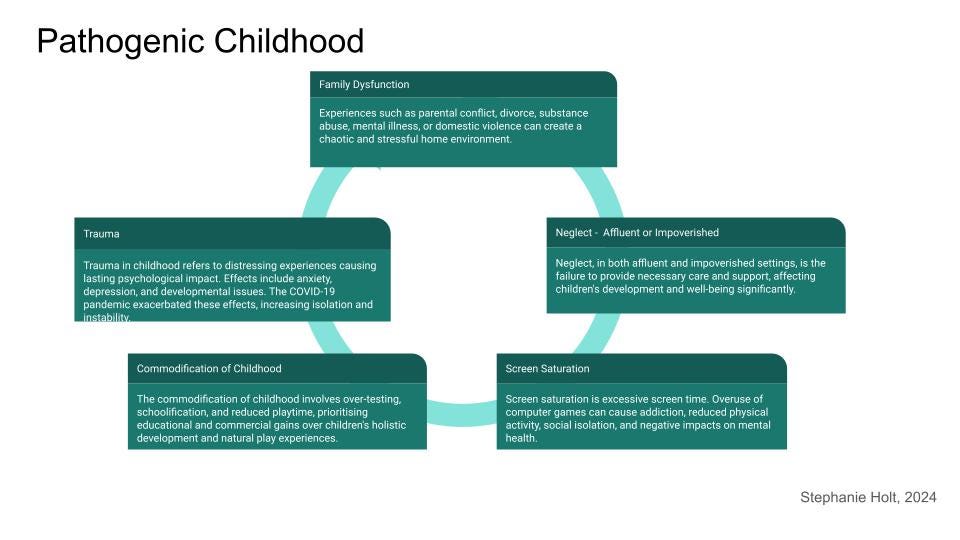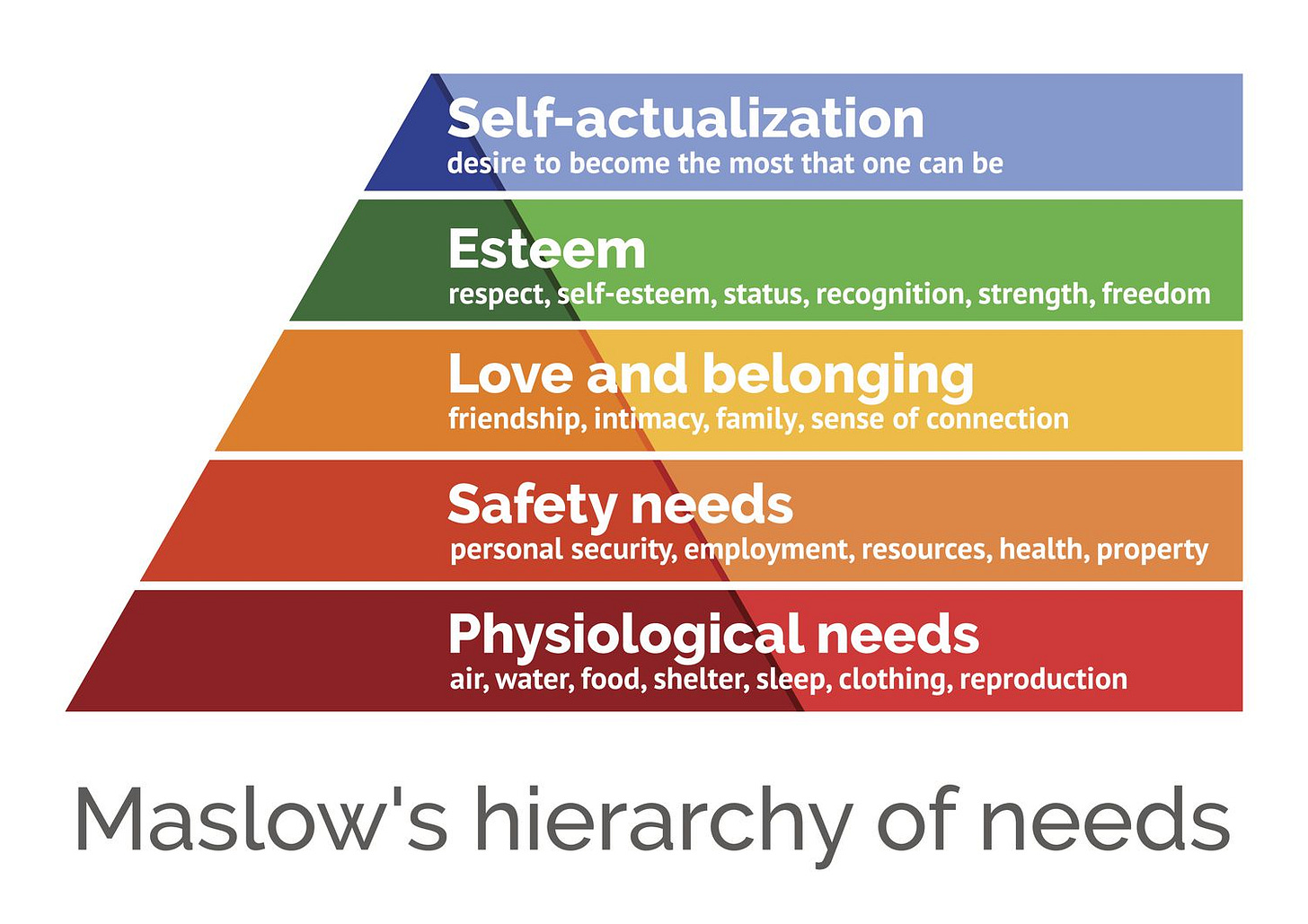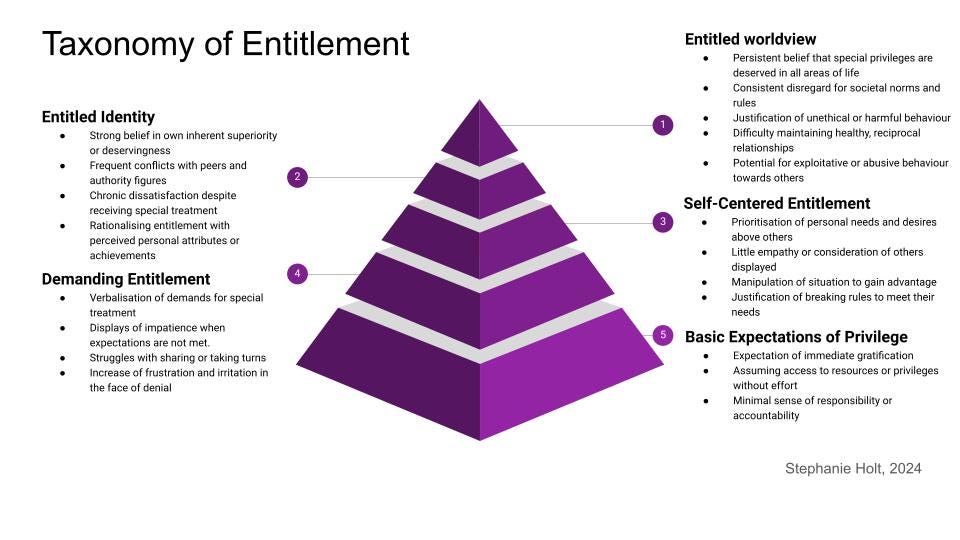
In 2006, Sue Palmer coined the term "Toxic Childhood" to describe the detrimental effects of contemporary culture on children. Fast forward to the post-pandemic world, and it seems "toxic" no longer encapsulates the full extent of the issues at hand. Instead, we are now facing a "Pathogenic Childhood," a metaphor that suggests these influences are not merely harmful but act as diseases in themselves. The post-pandemic environment has amplified these issues, creating a hazardous space for our children to grow, learn, and thrive.
The Pathogens of Childhood
The concept of Pathogenic Childhood can be broken down into several key factors, each acting as a pathogen that infects the developmental environment of children. These factors, as depicted in the accompanying diagram by Holt (2024), include Family Dysfunction, Trauma, Neglect (Affluent or Impoverished), Commodification of Childhood, and Screen Saturation.
Family Dysfunction
Family dysfunction encompasses experiences such as parental conflict, divorce, substance abuse, mental illness, or domestic violence. These experiences create chaotic and stressful home environments that disrupt a child's sense of security and stability. When the home, a supposed sanctuary, becomes a battleground, the child's emotional and psychological well-being takes a severe hit.
Trauma
Trauma in childhood refers to distressing experiences that cause lasting psychological impact. The COVID-19 pandemic has exacerbated these effects, increasing isolation and instability. Trauma can manifest as anxiety, depression, and developmental issues, leaving deep scars that affect a child's ability to function and learn effectively.
Neglect - Affluent or Impoverished
Neglect or the failure to provide necessary care and support, significantly impacts children's development and well-being. Interestingly, neglect can occur in both affluent and impoverished settings. In affluent families, emotional neglect might be masked by material abundance, while in impoverished families, the lack of basic resources leads to physical neglect.
Commodification of Childhood
The commodification of childhood with its over-testing, schoolification, and reduced playtime, prioritises educational and commercial gains over children's holistic development. This trend turns childhood into a business, where the joy of learning and play is sacrificed for academic performance and economic success. Much has been written about the need for play, but children in many countries are no longer allowed to independently play out of the view of adults leading to a loss of independence and ability to problem solve.
Screen Saturation
Screen saturation is the excessive screen time children are exposed to. The overuse of computer games and digital devices leads to addiction, reduced physical activity, social isolation, and negative impacts on mental health. While technology has its benefits, unregulated screen time can be a significant pathogen. Not to mention, I am sure every educator knows that most bullying is no longer physical or verbal, but happens outside of school through the mobile phone.
Pathogenic Childhood vs. Maslow's Hierarchy of Needs
To understand the impact of Pathogenic Childhood, it's helpful to compare it with Maslow's Hierarchy of Needs. Maslow's theory posits that humans have a series of needs, from basic physiological necessities to self-actualisation, that must be met for healthy development. Pathogenic Childhood disrupts these needs at every level:
https://www.thoughtco.com/maslows-hierarchy-of-needs-4582571
Physiological Needs: Neglect and screen saturation can lead to poor nutrition and sleep patterns.
Safety Needs: Family dysfunction and trauma undermine a child's sense of safety and security.
Love and Belonging: Emotional neglect and commodification of childhood affect a child's ability to form healthy relationships.
Esteem Needs: Screen saturation and commodification can lead to poor self-esteem and identity issues.
Self-Actualization: All these factors together inhibit a child's ability to reach their full potential.
In essence, while Maslow's Hierarchy of Needs outlines a pathway to deep learning and personal growth, Pathogenic Childhood creates a hostile environment where achieving these needs becomes increasingly difficult.
Generative AI: A New Pathogen?
Generative AI holds immense potential in education, but it also poses risks if not used ethically and with intention. When students use AI to cheat or shortcut their learning process, it becomes yet another pathogen. The ease of accessing information through AI can lead to a decline in critical thinking and problem-solving skills, which are essential for deep learning and intellectual growth. Yet Generative AI has the potential, when used with purpose, to act as an inoculation allowing older children to question their own learning and to use it to personalise their own experience. AI has the potential to augment and support HI (Human Intelligence) allowing students to excel in ways we have no idea about yet.
Entitlement: The Epidemic Within the Epidemic
Entitlement has become an increasingly prevalent issue among children growing up in the modern era. This phenomenon can be traced back to the various pathogens that constitute a Pathogenic Childhood. Entitlement refers to a belief that one is inherently deserving of privileges or special treatment without corresponding effort or merit. This mindset can have far-reaching consequences on a child's development and their ability to function effectively in society.
Roots of Entitlement
Several factors contribute to the rise of entitlement among children:
Material Abundance Without Emotional Support: In many families, children are often showered with material possessions and luxuries. While these can provide temporary satisfaction, they do not substitute for emotional support and nurturing. Without the balance of emotional care, children may come to equate love and worth with material goods, fostering a sense of entitlement.
Overprotective Parenting: Helicopter parenting, where parents are overly involved in their children's lives, shielding them from any form of failure or discomfort, can lead to entitlement. These children may grow up without learning resilience or the importance of effort, expecting that everything will be handed to them on a silver platter.
Lack of Responsibility and Consequences: When children are not held accountable for their actions and face no real consequences, they may develop an inflated sense of their own importance. This lack of accountability can prevent them from understanding the value of hard work and the importance of personal responsibility.
Manifestations of Entitlement
Children with a sense of entitlement often exhibit specific behaviours and attitudes:
Unrealistic Expectations: They may expect to receive rewards and recognition without putting in the corresponding effort. This can manifest in academic settings, where they believe they deserve high grades regardless of their performance.
Poor Coping Mechanisms: Entitled children often struggle to handle failure or criticism. When things do not go their way, they may react with frustration, anger, or withdrawal instead of using the experience as a learning opportunity.
Lack of Empathy: These children may find it challenging to understand and respect the needs and feelings of others. Their focus on their own desires can lead to selfish behaviour and difficulty in forming healthy relationships.
Dependency on External Validation: Entitled children often seek validation and approval from external sources rather than developing an internal sense of self-worth. This dependency can lead to insecurity and a constant need for affirmation.
Long-term Consequences
The long-term effects of entitlement can be detrimental, both for the individual and society:
Academic and Career Challenges: In academic and professional settings, entitlement can hinder performance and progress. Without the skills to work hard and persevere, entitled individuals may struggle to achieve their goals and adapt to the demands of the workplace.
Interpersonal Difficulties: Entitlement can strain relationships with peers, family members, and colleagues. The lack of empathy and understanding can lead to conflicts and isolation.
Mental Health Issues: The constant need for external validation and the inability to cope with failure can contribute to mental health issues such as anxiety, depression, and low self-esteem.
The Explosion of Additional Needs
The current environment has led to an explosion of additional needs among children, such as ADHD, neurodiversity, entitlement, poor self-esteem, and mental health issues.
Improved Awareness and Diagnosis
Enhanced Diagnostic Criteria
Legislative and Policy Changes
Increased Inclusion
Societal Changes
Environmental and Genetic Factors
Technological Advancements
Educational Pressures
Economic and Social Factors
Parental Advocacy
The increase in the identification and diagnosis of special educational needs (SEN) can be attributed to several factors. Improved awareness and diagnosis, along with enhanced diagnostic criteria, have made it easier to identify and understand various conditions such as autism spectrum disorder (ASD), ADHD, and dyslexia. Legislative changes and policies mandating support for students with SEN have formalised the identification process, while modern educational philosophies promoting inclusion have integrated more students with diverse needs into mainstream classrooms. Societal changes have reduced the stigma around SEN, encouraging more parents to seek help. Environmental and genetic factors, along with advancements in technology, have also played a role in highlighting and addressing learning challenges. Increased academic pressures and standardised testing reveal learning difficulties that might have previously gone unnoticed. Economic and social factors, including better access to healthcare and education services, contribute to higher diagnosis rates. Parental advocacy has become stronger, leading to more identification and provision of services for children with SEN. This multifaceted issue reflects progress in recognising and supporting diverse learning needs while highlighting the need for continued improvements in education and healthcare systems.
The Skills Gap
The multitude of pathogens affecting childhood today makes it challenging for children to develop 21st-century skills such as critical thinking, creativity, collaboration, and communication. If not addressed, the skills gap will continue to widen, creating a generation ill-equipped to face the demands of the future workforce.
Teaching as the Inoculation
Amidst this landscape of Pathogenic Childhood, teaching emerges as the inoculation against these harmful influences. Educators play a crucial role in creating supportive, stable, and enriching environments that counteract the effects of these pathogens. By fostering emotional resilience, critical thinking, and a love for learning, teachers can help children navigate the challenges of the modern world.
Final Thoughts
The concept of Pathogenic Childhood reflects the multifaceted and deeply embedded issues facing today's children. Inoculating against these pathogens requires a concerted effort from parents, educators, and society at large. By recognising and mitigating these factors, we can create healthier, more supportive environments that allow our children to thrive and reach their full potential. We ignore the current state of childhood at our peril, while setting our children up to fail because they simply cannot learn in this gilded cage.
References:
Bernard, C., 2019. Recognizing and addressing child neglect in affluent families. Child & Family Social Work, 24(2), pp.340-347.
Bradbury, A., 2020. Datafied at four: The role of data in the ‘schoolification’ of early childhood education in England. In The Datafication of Education (pp. 8-22). Routledge.
de Oliveira Brito, R. and Nogueira, A., 2012. Consumer society, commodification of childhood and current challenges for education. In INTED2012 Proceedings (pp. 2954-2959). IATED.
Hinshaw, S.P. and Scheffler, R.M., 2014. The ADHD explosion: Myths, medication, money, and today's push for performance. Oxford University Press.
Holt, S., 2024. Pathogenic Childhood Diagram.
Holt, S., 2024. Taxonomy of Entitlement Diagram.
Lee, K.M. and Peng, W., 2006. What do we know about social and psychological effects of computer games? A comprehensive review of the current literature. In Playing video games: Motives, responses, and consequences (pp.327-345).
Palmer, S., 2006. Toxic Childhood: How The Modern World Is Damaging Our Children And What We Can Do About It. Orion.
Sitler, H.C., 2009. Teaching with awareness: The hidden effects of trauma on learning. The Clearing House: A Journal of Educational Strategies, Issues and Ideas, 82(3), pp.119-124.
Smith, M., 2020. Maslow's Hierarchy of Needs. ThoughtCo. Available at: https://www.thoughtco.com/maslows-hierarchy-of-needs-4582571 [Accessed 16 July. 2024].
Subrahmanyam, K., Michikyan, M., Clemmons, C., Carrillo, R., Uhls, Y.T. and Greenfield, P.M., 2013. Learning from paper, learning from screens: Impact of screen reading and multitasking conditions on reading and writing among college students. International Journal of Cyber Behavior, Psychology and Learning (IJCBPL), 3(4), pp.1-27.
Szcześniak, M. and Tułecka, M., 2020. Family functioning and life satisfaction: The mediatory role of emotional intelligence. Psychology Research and Behavior Management, pp.223-232.






This kind of childhood experience existed long before Palmer gave it a name- unfortunately, mainly because of patriarchal authority structures, it was common.